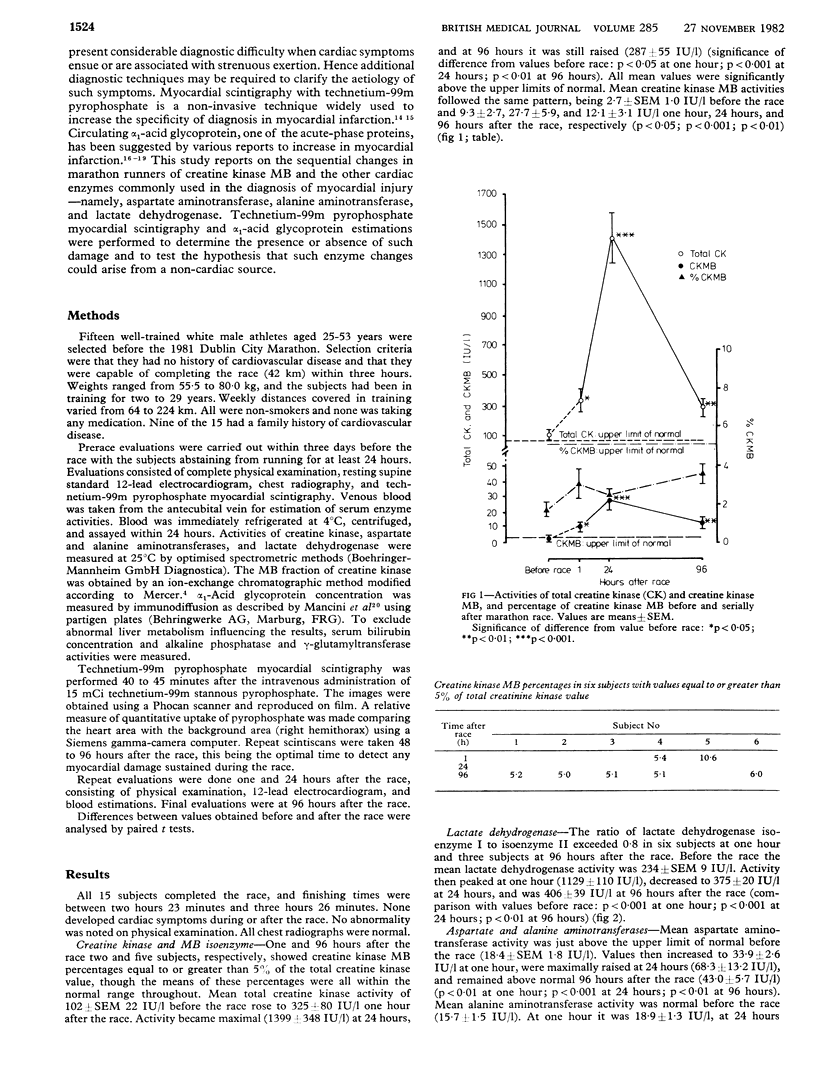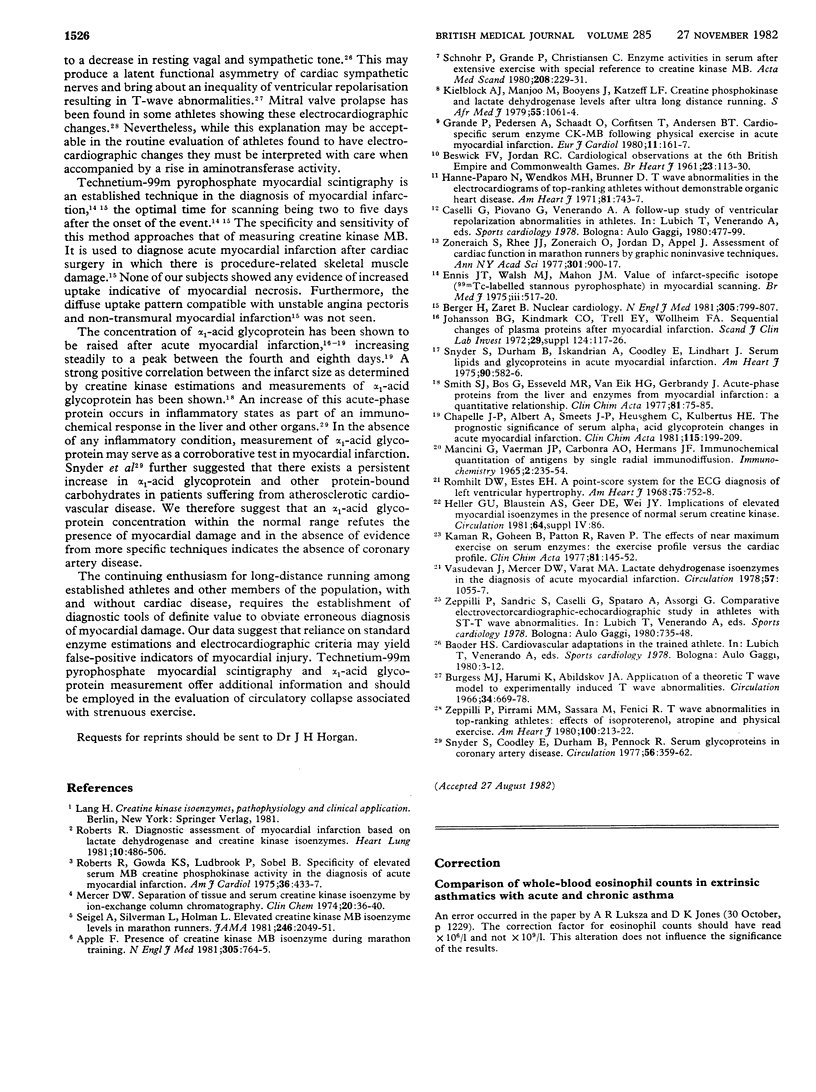Abstract
Serial estimations of activities of creatine kinase and its MB isoenzyme, aspartate aminotransferase, alanine aminotransferase, and lactate dehydrogenase and of concentrations of alpha1-acid glycoprotein were performed in 15 healthy well-trained male marathon runners. Estimations were made initially within three days before a race and then one, 24, and 96 hours after the race. Technetium-99m pyrophosphate myocardial scintigraphy was carried out at the initial prerace assessment and repeated 48 to 96 hours after the race. None of the subjects developed cardiac symptoms during or after the race.
Activities of creatine kinase and creatine kinase MB became maximal 24 hours after the race. One and 96 hours after the race two and five subjects, respectively, showed amounts of creatine kinase MB totalling 5% or more of total creatine kinase. Lactate dehydrogenase activity peaked at one hour after the race, and activities of aspartate and alanine aminotransferases peaked at 24 and 96 hours after the race, respectively. Activities of all these enzymes showed a significant increase from prerace values during the rest of the study. Electrocardiographic features noted were similar to those reported elsewhere in athletes under similar conditions. They included first-degree heart block, incomplete right bundle-branch block, left ventricular hypertrophy, pseudoischaemic T-wave changes, and early repolarisation of variant ST-segment elevations in precordial leads. Technetium-99m pyrophosphate myocardial scintigraphy did not show evidence of myocardial damage before or after the race. Alpha1-acid glycoprotein concentrations were normal throughout.
These data suggest that reliance on standard enzyme estimations and electrocardiographic criteria may yield false-positive indicators of myocardial injury during prolonged strenuous exercise. Technetium-99m pyrophosphate scintigraphy and alpha1-acid glycoprotein measurements offer additional information and may usefully be employed in evaluating circulatory collapse associated with such exercise.
Full text
PDF



Selected References
These references are in PubMed. This may not be the complete list of references from this article.
- Apple F. S. Presence of creatine kinase MB isoenzyme during marathon training. N Engl J Med. 1981 Sep 24;305(13):764–765. doi: 10.1056/nejm198109243051314. [DOI] [PubMed] [Google Scholar]
- Berger H. J., Zaret B. L. Nuclear cardiology (first of two parts). N Engl J Med. 1981 Oct 1;305(14):799–807. doi: 10.1056/NEJM198110013051405. [DOI] [PubMed] [Google Scholar]
- Beswick F. W., Jordan R. C. CARDIOLOGICAL OBSERVATIONS AT THE SIXTH BRITISH EMPIRE AND COMMONWEALTH GAMES. Br Heart J. 1961 Mar;23(2):113–130. doi: 10.1136/hrt.23.2.113. [DOI] [PMC free article] [PubMed] [Google Scholar]
- Burgess M. J., Harumi K., Abildskov J. A. Application of a theoretic T-wave model to experimentally induced T-wave abnormalities. Circulation. 1966 Oct;34(4):669–678. doi: 10.1161/01.cir.34.4.669. [DOI] [PubMed] [Google Scholar]
- Chapelle J. P., Albert A., Smeets J. P., Heusghem C., Kulbertus H. E. The prognostic significance of serum alpha 1-acid glycoprotein changes in acute myocardial infarction. Clin Chim Acta. 1981 Sep 10;115(2):199–209. doi: 10.1016/0009-8981(81)90076-0. [DOI] [PubMed] [Google Scholar]
- Ennis J. T., Walsh M. J., Mahon J. M. Value of infarct-specific isotope (99mTc-labelled stannous pyrophosphate) in myocardial scanning. Br Med J. 1975 Aug 30;3(5982):517–520. doi: 10.1136/bmj.3.5982.517. [DOI] [PMC free article] [PubMed] [Google Scholar]
- Grande P., Pedersen A., Schaadt O., Corfitsen T., Andersen B. T. Cardio-specific serum enzyme CK--MB following physical exercise in acute myocardial infarction. Eur J Cardiol. 1980 Mar;11(3):161–167. [PubMed] [Google Scholar]
- Hanne-Paparo N., Wendkos M. H., Brunner D. T wave abnormalities in the electrocardiograms of top-ranking athletes without demonstrable organic heart disease. Am Heart J. 1971 Jun;81(6):743–747. doi: 10.1016/0002-8703(71)90078-0. [DOI] [PubMed] [Google Scholar]
- Johansson B. G., Kindmark C. O., Trell E. Y., Wollheim F. A. Sequential changes of plasma proteins after myocardial infarction. Scand J Clin Lab Invest Suppl. 1972;124:117–126. doi: 10.3109/00365517209102759. [DOI] [PubMed] [Google Scholar]
- Kaman R. L., Goheen B., Patton R., Raven P. The effects of near maximum exercise of serum enzymes: the exercise profile versus the cardiac profile. Clin Chim Acta. 1977 Dec 1;81(2):145–152. doi: 10.1016/0009-8981(77)90006-7. [DOI] [PubMed] [Google Scholar]
- Kielblock A. J., Manjoo M., Booyens J., Katzeff I. E. Creatine phosphokinase and lactate dehydrogenase levels after ultra long-distance running. An analysis of iso-enzyme profiles with special reference to indicators of myocardial damage. S Afr Med J. 1979 Jun 23;55(26):1061–1064. [PubMed] [Google Scholar]
- Mancini G., Carbonara A. O., Heremans J. F. Immunochemical quantitation of antigens by single radial immunodiffusion. Immunochemistry. 1965 Sep;2(3):235–254. doi: 10.1016/0019-2791(65)90004-2. [DOI] [PubMed] [Google Scholar]
- Mercer D. W. Separation of tissue and serum creatine kinase isoenzymes by ion-exchange column chromatography. Clin Chem. 1974;20(1):36–40. [PubMed] [Google Scholar]
- Roberts R. Diagnostic assessment of myocardial infarction based on lactate dehydrogenase and creatine kinase isoenzymes. Heart Lung. 1981 May-Jun;10(3):486–506. [PubMed] [Google Scholar]
- Roberts R., Gowda K. S., Ludbrook P. A., Sobel B. E. Specificity of elevated serum MB creatine phosphokinase activity in the diagnosis of acute myocardial infarction. Am J Cardiol. 1975 Oct 6;36(4):433–437. doi: 10.1016/0002-9149(75)90890-5. [DOI] [PubMed] [Google Scholar]
- Romhilt D. W., Estes E. H., Jr A point-score system for the ECG diagnosis of left ventricular hypertrophy. Am Heart J. 1968 Jun;75(6):752–758. doi: 10.1016/0002-8703(68)90035-5. [DOI] [PubMed] [Google Scholar]
- Schnohr P., Grande P., Christiansen C. Enzyme activities in serum after extensive exercise, with special reference to creatine kinase MB. Acta Med Scand. 1980;208(3):229–231. doi: 10.1111/j.0954-6820.1980.tb01183.x. [DOI] [PubMed] [Google Scholar]
- Siegel A. J., Silverman L. M., Holman B. L. Elevated creatine kinase MB isoenzyme levels in marathon runners. Normal myocardial scintigrams suggest noncardiac source. JAMA. 1981 Nov 6;246(18):2049–2051. [PubMed] [Google Scholar]
- Smith S. J., Bos G., Esseveld M. R., Van Eijk H. G., Gerbrandy J. Acute-phase proteins from the liver and enzymes from myocardial infarction; a quantitative relationship. Clin Chim Acta. 1977 Nov 15;81(1):75–85. doi: 10.1016/0009-8981(77)90415-6. [DOI] [PubMed] [Google Scholar]
- Snyder S., Coodley E. L., Durham B. C., Pennock R. S. Serum glycoproteins in coronary artery disease. Circulation. 1977 Sep;56(3):359–362. doi: 10.1161/01.cir.56.3.359. [DOI] [PubMed] [Google Scholar]
- Snyder S., Durham B. C., Iskandrian A. S., Coodley E. L., Linhart J. W. Serum lipids and glycoproteins in acute myocardial infarction. Am Heart J. 1975 Nov;90(5):582–586. doi: 10.1016/0002-8703(75)90221-5. [DOI] [PubMed] [Google Scholar]
- Vasudevan G., Mercer D. W., Varat M. A. Lactic dehydrogenase isoenzyme determination in the diagnosis of acute myocardial infarction. Circulation. 1978 Jun;57(6):1055–1057. doi: 10.1161/01.cir.57.6.1055. [DOI] [PubMed] [Google Scholar]
- Zeppilli P., Pirrami M. M., Sassara M., Fenici R. T wave abnormalities in top-ranking athletes: effects of isoproterenol, atropine, and physical exercise. Am Heart J. 1980 Aug;100(2):213–222. doi: 10.1016/0002-8703(80)90117-9. [DOI] [PubMed] [Google Scholar]
- Zoneraich S., Rhee J. J., Zoneraich O., Jordan D., Appel J. Assessment of cardiac function in marathon runners by graphic noninvasive techniques. Ann N Y Acad Sci. 1977;301:900–917. doi: 10.1111/j.1749-6632.1977.tb38257.x. [DOI] [PubMed] [Google Scholar]


